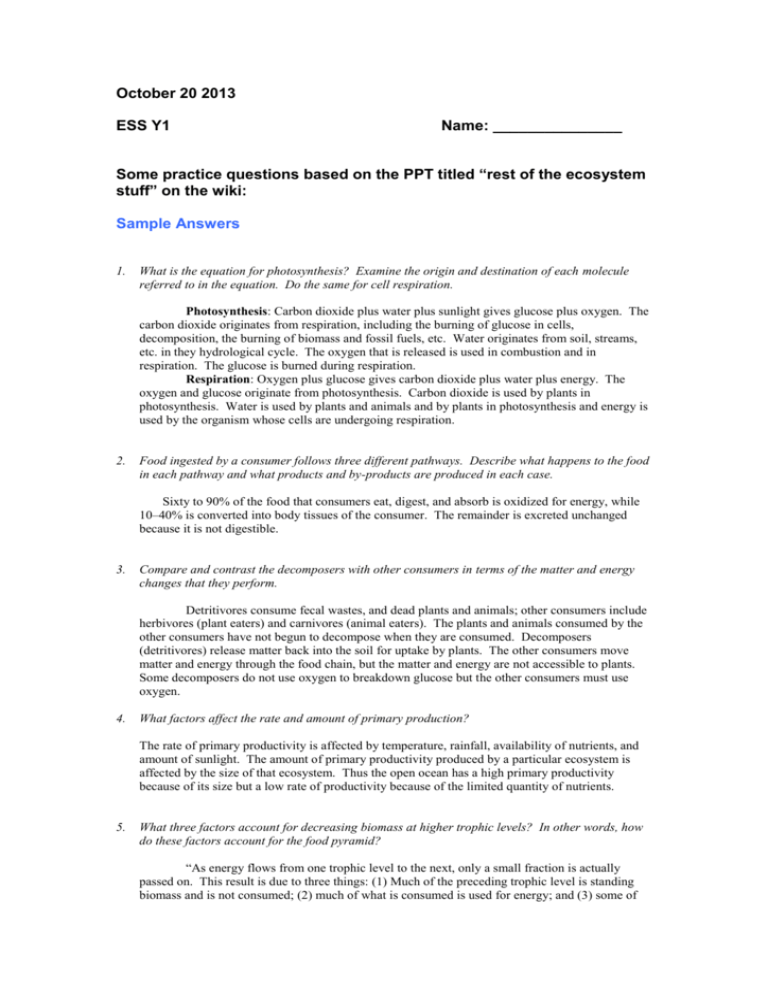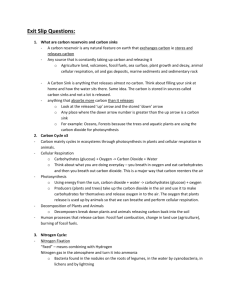Last PPT Practice Qs
advertisement

October 20 2013 ESS Y1 Name: _______________ Some practice questions based on the PPT titled “rest of the ecosystem stuff” on the wiki: Sample Answers 1. What is the equation for photosynthesis? Examine the origin and destination of each molecule referred to in the equation. Do the same for cell respiration. Photosynthesis: Carbon dioxide plus water plus sunlight gives glucose plus oxygen. The carbon dioxide originates from respiration, including the burning of glucose in cells, decomposition, the burning of biomass and fossil fuels, etc. Water originates from soil, streams, etc. in they hydrological cycle. The oxygen that is released is used in combustion and in respiration. The glucose is burned during respiration. Respiration: Oxygen plus glucose gives carbon dioxide plus water plus energy. The oxygen and glucose originate from photosynthesis. Carbon dioxide is used by plants in photosynthesis. Water is used by plants and animals and by plants in photosynthesis and energy is used by the organism whose cells are undergoing respiration. 2. Food ingested by a consumer follows three different pathways. Describe what happens to the food in each pathway and what products and by-products are produced in each case. Sixty to 90% of the food that consumers eat, digest, and absorb is oxidized for energy, while 10–40% is converted into body tissues of the consumer. The remainder is excreted unchanged because it is not digestible. 3. Compare and contrast the decomposers with other consumers in terms of the matter and energy changes that they perform. Detritivores consume fecal wastes, and dead plants and animals; other consumers include herbivores (plant eaters) and carnivores (animal eaters). The plants and animals consumed by the other consumers have not begun to decompose when they are consumed. Decomposers (detritivores) release matter back into the soil for uptake by plants. The other consumers move matter and energy through the food chain, but the matter and energy are not accessible to plants. Some decomposers do not use oxygen to breakdown glucose but the other consumers must use oxygen. 4. What factors affect the rate and amount of primary production? The rate of primary productivity is affected by temperature, rainfall, availability of nutrients, and amount of sunlight. The amount of primary productivity produced by a particular ecosystem is affected by the size of that ecosystem. Thus the open ocean has a high primary productivity because of its size but a low rate of productivity because of the limited quantity of nutrients. 5. What three factors account for decreasing biomass at higher trophic levels? In other words, how do these factors account for the food pyramid? “As energy flows from one trophic level to the next, only a small fraction is actually passed on. This result is due to three things: (1) Much of the preceding trophic level is standing biomass and is not consumed; (2) much of what is consumed is used for energy; and (3) some of what is consumed is undigested and passes through the organism.” “(A) very large portion of the primary-producer trophic level is not consumed in the grazing food web. As this material dies, it is joined by the fecal wastes and dead bodies from higher trophic levels and represents the starting point for a separate food web.” Very little energy that enters one trophic level moves to the next trophic level—approximately 10%. “At each trophic level, some energy goes into growth, some is converted to heat, and some is given off as waste or is not consumed.” 6. Describe the biogeochemical cycle of carbon as it moves into and through organisms and back to the environment. Do the same for phosphorus and nitrogen. Carbon cycle: The carbon cycle “begins” with the two reservoirs: carbon dioxide in the atmosphere and bicarbonate molecules in water. Carbon atoms from carbon dioxide are incorporated into producers through the process of photosynthesis. The carbon in producers is transferred to consumers via the food web. Carbon is released back to the atmosphere through decomposition by decomposers and detritus feeders. Respiration releases carbon as carbon dioxide for land-based organisms and as inorganic carbonate in aquatic ecosystems. Non-trophic transfers of carbon include the geological sedimentation of carbon, thereby removing carbon from solution, and the combustion of fossil fuel carbon, thereby releasing carbon to the atmosphere. The main impact humans have on the carbon cycle is through the burning of fossil fuels and deforestation, resulting in increased levels of carbon dioxide in the atmosphere. 7. What are the major human intrusions into each of the carbon, phosphorus, and nitrogen cycles? The major human intrusions into the carbon cycle are the release of carbon through the combustion of fossil fuels and the burning/destruction of forests. The major human intrusion into the phosphorus cycle comes from the use of phosphorus-containing fertilizers. The major human intrusion into the nitrogen cycle comes from the use of nitrogen fertilizers, the planting of nitrogen fixing crops, and the combustion of fossil fuels “fixing” nitrogen from the air. 8. What are two essential keys to ecosystem sustainability? “Compare human use of solar energy with our use of fossil-fuel energy. What problems are prominent? We use solar energy in natural and agricultural ecosystems. Agriculture provides most of our food. “(W)e have converted almost 11% of Earth’s land area from forest and grassland biomes to agricultural ecosystems.” “(H)umans currently appropriate 32% of (the total annual global net primary production) for agriculture, grazing, forestry, and human-occupied lands.” If other humans activities are included, (e.g., highways, housing, dumps, etc.), it is estimated that humans appropriate another 8% of primary productivity. Combustion of fossil fuels releases 6.6 petagrams of carbon as well as 35 teragrams of nitrogen and 50 teragrams of sulfur. Air pollution including urban smog, acid rain, and the potential for global climate change are by-products of the burning of fossil fuels. In addition, mercury and other toxic compounds are released during the burning of some fossil fuels. We are expected to have depleted petroleum in the near future.









